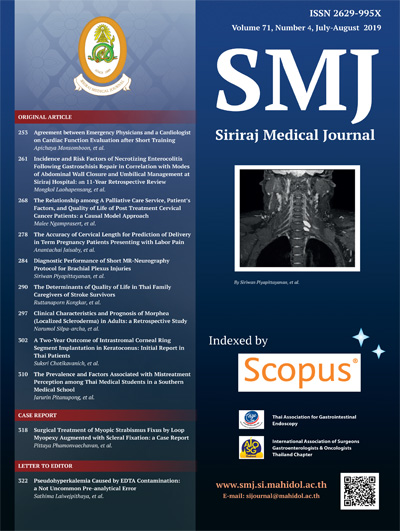Clinical Characteristics and Prognosis of Morphea (Localized Scleroderma) in Adults: a Retrospective Study
DOI:
https://doi.org/10.33192/Smj.2019.45Keywords:
Morphea; prognosis; phototherapy; systemic; treatmentAbstract
Objective: To study the clinical characteristics and prognosis of morphea in Thai adult patients.
Methods: The medical records of 81 morphea adult patients who visited Siriraj Hospital, Thailand, between 2006 and 2015, were retrospectively reviewed. The demographics, clinical features, treatments and outcomes were analyzed. Clinical improvement was categorized as excellent (>80%), partial (1%–80%), and no response.
Results: Circumscribed morphea was the most common subtype (34, 42%) of the 81 patients, followed by linear morphea (21, 26%), generalized morphea (14, 17%), en coup de sabre (11, 14%) and Parry–Romberg syndrome (1, 1%). Systemic treatment and ultraviolet A (UVA)1 phototherapy had satisfactory outcomes in 83% and 79%
of cases, respectively, providing a partial to excellent response. For overall remission, one year after the treatment, 30% of patients achieved a partial to excellent response. After 2 years, this proportion rose to 50%. The median time to clinical response was 24 months.
Conclusion: Morphea is a difficult-to-treat dermatosis, with the majority of the patients having a partial clinical response and a high recurrent rate. Combination of treatment might be a worthy option.
Downloads
Published
How to Cite
Issue
Section
License
Authors who publish with this journal agree to the following conditions:
Copyright Transfer
In submitting a manuscript, the authors acknowledge that the work will become the copyrighted property of Siriraj Medical Journal upon publication.
License
Articles are licensed under a Creative Commons Attribution-NonCommercial-NoDerivatives 4.0 International License (CC BY-NC-ND 4.0). This license allows for the sharing of the work for non-commercial purposes with proper attribution to the authors and the journal. However, it does not permit modifications or the creation of derivative works.
Sharing and Access
Authors are encouraged to share their article on their personal or institutional websites and through other non-commercial platforms. Doing so can increase readership and citations.















